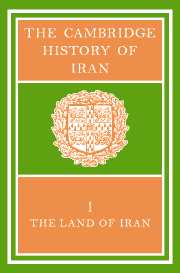Book contents
- Frontmatter
- PART 1 THE LAND
- PART 2 THE PEOPLE
- PART 3 ECONOMIC LIFE
- 15 MINERALS
- 16 INDUSTRIAL ACTIVITIES
- 17 COMMUNICATIONS, TRANSPORT, RETAIL TRADE AND SERVICES
- 18 AGRICULTURE
- 19 WATER USE IN NORTH-EAST IRAN
- 20 PASTORALISM, NOMADISM AND THE SOCIAL ANTHROPOLOGY OF IRAN
- 21 LAND REFORM IN IRAN
- PART 4 CONCLUSION
- Bibliography
- Conversion Tables
- Fig. I. Iran: physiographical.
- Plate Section
- Fig 85. Soil potentiality map of Iran.
- References
17 - COMMUNICATIONS, TRANSPORT, RETAIL TRADE AND SERVICES
from PART 3 - ECONOMIC LIFE
Published online by Cambridge University Press: 28 March 2008
- Frontmatter
- PART 1 THE LAND
- PART 2 THE PEOPLE
- PART 3 ECONOMIC LIFE
- 15 MINERALS
- 16 INDUSTRIAL ACTIVITIES
- 17 COMMUNICATIONS, TRANSPORT, RETAIL TRADE AND SERVICES
- 18 AGRICULTURE
- 19 WATER USE IN NORTH-EAST IRAN
- 20 PASTORALISM, NOMADISM AND THE SOCIAL ANTHROPOLOGY OF IRAN
- 21 LAND REFORM IN IRAN
- PART 4 CONCLUSION
- Bibliography
- Conversion Tables
- Fig. I. Iran: physiographical.
- Plate Section
- Fig 85. Soil potentiality map of Iran.
- References
Summary
Up to the last decades of the nineteenth century, trails and caravan routes were the only means of communications with Iran. Marked relief, particularly near boundaries and seacoasts, together with limited commercial activities, had discouraged the construction of highways and railways. Exports consisted mainly of carpets, which could travel by pack-horse or camel; and imports were handled in the same manner. Wheeled traffic was rare and limited to local transport within a few towns and oases. Retail trade in bāzārs and by pedlars included very few imported goods: most of these were traded second-hand. Only Tabrīz, Rasht, and Tehrān in the north, and Bushire [Būshahr] and Bandar ‘Abbās in the south, traded regularly with foreign countries. Other towns and villages were almost entirely self-sufficient, and pilgrims provided their major contact with other parts of the country and with the holy places of the Muslim world. Modern medical and other services were available only at foreign missions, both governmental and private, and then only sporadically.
This position began to change in the late 1880s with the gradual introduction of new means of transport. Both Great Britain and Russia participated in these developments, which immediately increased the scope and volume first of internal trade and later of services. In most towns bāzārs began to expand. Change was rather slow, however, until the introduction of the motor-car during World War I; and the speed of change further increased during the 1930s by the construction of the Trans-Iranian Railway. As a result, local self-sufficiency was reduced considerably, causing a substantial urban growth.
- Type
- Chapter
- Information
- The Cambridge History of Iran , pp. 552 - 564Publisher: Cambridge University PressPrint publication year: 1968
References
- 1
- Cited by



